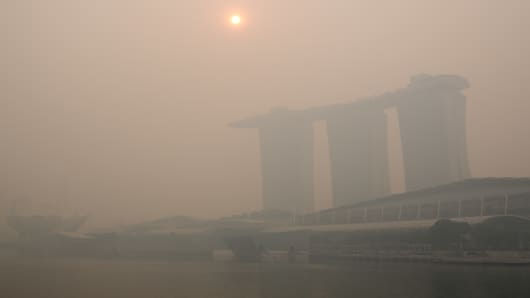Dogs & Haze/ Pollution
- Fraser Noble

- Oct 10, 2023
- 3 min read

Although better in recent years, there was a time here in Singapore where it was an annual thing that haze(pollution) from the burning of Forrest's in Indonesia would take over the sky's. This obviously has a great effect of both animals and humans.

This year we have seen an rise in this again, as such I have seen people questioning on whether we should walk our dogs outside when the PSI (Pollutant Standard Index) is high.
We certainly want to keep walking our dogs during haze, however it's important to understand that poor air quality can have significant effects on your dog's health and behavior. Here are some ways in which it can impact them:
1. Respiratory Issues: Dogs, like humans, can suffer from respiratory problems when exposed to pollutants in the air. These pollutants can irritate their airways, leading to symptoms such as coughing, wheezing, sneezing, and difficulty breathing.

2. Allergies: Poor air quality can exacerbate allergies in dogs. Pollen, dust, and other allergens can become more concentrated in the air, causing allergic reactions like itching, skin problems, and runny noses.
3. Agitation and Anxiety: Dogs may become more anxious or agitated when exposed to high levels of pollution. The discomfort from respiratory issues or allergies can lead to restlessness and behavioral changes.
4. Reduced Exercise Tolerance: Dogs may become less active and have reduced exercise tolerance in polluted environments due to breathing difficulties. This can affect their overall fitness and well-being.
5. Aggravation of Pre-existing Conditions: Poor air quality can worsen pre-existing health conditions in dogs, such as asthma or heart disease, making it crucial to manage their environment carefully.
6. Lower Energy Levels: Dogs may appear lethargic or have lower energy levels when exposed to polluted air, as their bodies work harder to cope with the effects of pollution.

7. Irritated Eyes and Nose: Dogs can experience irritation of the eyes and nose when exposed to pollutants, leading to excessive tearing, redness, or discharge.
8. Behavioral Changes: Dogs may exhibit changes in behavior, such as restlessness, increased pacing, or seeking shelter indoors, as they try to cope with the discomfort caused by poor air quality.
9. Long-term Health Risks: Chronic exposure to high levels of air pollution can contribute to long-term health issues in dogs, including a higher risk of respiratory diseases and cardiovascular problems.

To protect your dog's health and behavior in poor air quality, it's essential to be proactive and take steps to minimize exposure to pollutants, this can help keep your dog healthy and comfortable. Although we should continue to walk our dogs, we need to take some things into consideration.
1. Choose Off-Peak Times: Walk your dog during times when pollution levels are lower, typically early morning or late evening.
2. Check Air Quality: Use reliable air quality monitoring apps or websites to check PSI levels in your area before heading out for a walk.
3. Shorten Walks: Consider shorter walks during high PSI days to minimize your dog's exposure.
4. Indoor Play: On days with extremely poor air quality, have a shorter toilet walk and engage your dog in indoor activities like training, interactive toys or games to avoid outdoor exposure. Your dog will still need their activity requirements reached daily, failure to do this may result in behavioural issues arising.

5. Choose Green Spaces: Opt for parks and areas with more greenery, as trees can help filter the air to some extent.
6. Hydration: Ensure your dog stays hydrated, as pollution can exacerbate respiratory issues. Carry water and a bowl for your dog.
7. Monitor Symptoms: Keep an eye on your dog for signs of distress like excessive coughing, wheezing, or labored breathing. If you notice any issues, consult your vet immediately.
8. Grooming: Regularly groom and wash your dog to remove pollutants that may stick to their fur.
9. Ventilation & Air Purification : When returning home, ensure good ventilation or have an air purifier running to clear any pollutants that might have come inside.
Remember that each dog is unique, and their tolerance to pollution may vary. Dogs with breathing issues will need additional care.
DISCLAIMER: I am not a medical veterinarian. I am a behavioral consultant and trainer. If you are worried about anything medical with regards to the haze and your dog, please consult your vet.
Picture is of a dog in mist. Not pollution.
%202_JPG.jpg)



Comments